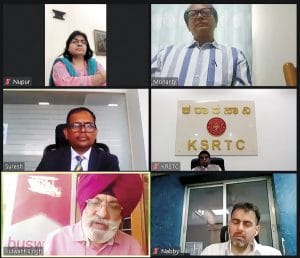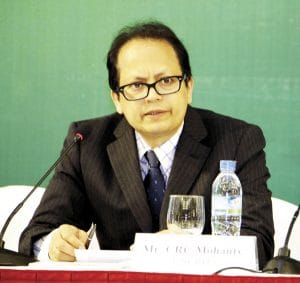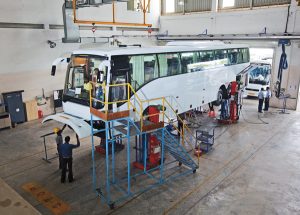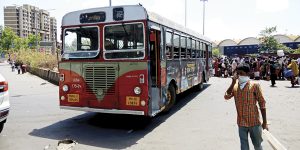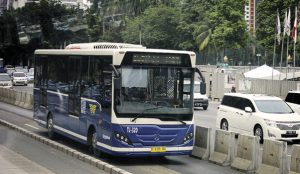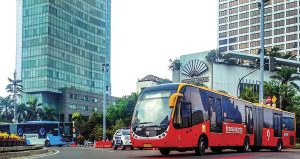A recent webinar organised by Busworld India saw experts discuss measures to re-energise the bus ecosystem
Story by Deven Lad
After a compulsory leave of a little over two months, the bus industry in India has begun to shift gears. It is doing so amid numerous difficulties, the most acute being the need for working capital and a reduction in occupancy rate due to the need for social distancing. A recent webinar organised by Busworld India highlighted these challenges and got experts to discuss ways to re-energise the bus ecosystem. Moderated by Kulwant Singh, Advisor, Busworld Academy, the webinar, drawing the attendance of over 500 people, got experts to look at ways to get the bus industry to find its animal spirit once again. Expressed C.R.C. Mohanty, Environment Programme Coordinator at the United Nations Centre for Regional Development (UNCRD), that public transport should be resumed as early as possible. “This would increase connectivity, which is important to ensure that labourers, farmers and many others find their means of livelihood once again,” he mentioned. Stating that buses are a key contributor for sustenance, Mohanty said that they have been providing accessibility and connectivity, which is key to development.
Stressing on India Accounting for only 0.8 per cent of the world’s bus population, Mohanty said that there was a need for another two lakh buses in view of the growing demand in the urban sector and to improve rural-urban connectivity. Explaining that there were only 14 buses for every one-lakh worth of population in India, he averred that connectivity is crucial for the country’s economy and activities to once again gain the necessary form and function. Suggesting that the restoration of public trust is essential to resume transportation, Mohanty urged bus operators to take stringent measures like sanitisation, wearing of masks, crowd control, and contactless ticketing. Expressing that the Government should facilitate the need for finance by the bus industry, he called upon the operators to support their drivers and other staff.
Challenges, and more challenges
Explaining that there was a need to provide drivers, other staff and even the passengers with hygienic washroom facilities, Mohanty pointed at the need for secured parking and the provision of hygienic food and water to the bus staff. Suggesting bus manufacturers to consider changing their bus design methodology to incorporate AI and features like transparent separators, he averred that every bus industry stakeholder should strictly follow the rules laid down by the World Health Organisation (WHO) to fight the pandemic. Announced Shivayogi C. Kalasad, Managing Director, Karnataka State Road Transport Corporation (KSRTC), said that they have been paying much attention to employee and passenger safety. Stating that his organisation has been into the movement of labourers, Kalasad informed that KSRTC has a fleet of 8500 buses and 32000 employees.
Revealing that Covid-19 has made them look inward, he mentioned that they are facing operational, financial, fleet and health management challenges. Practising sanitisation, providing protection gear to employees and following the guidelines laid down by the government and regional authorities, KSRTC, said Kalasad, has also taken to manufacturing masks at its workshops. Regularly conducting awareness programmes, the organisation also took to operating 20 mobile clinics for Covid-19 testing and awareness. Old buses, said Kalasad, were converted for the purpose. Ferrying 1.19 lakh labourers to 76 different states until June 01, 2020, KSRTC, with a ridership of three-million, chalked a schedule starting with the operation of 1000 buses in the first week after resuming operation after a hiatus of two months.
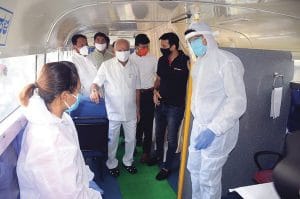 Mobilising another 1000 buses in the next week, the organisation has come to operate 3500 buses thus far. Witnessing the financial cost of running the bus fleet to exceed that of the income, KSRTC is being supported by the Karnataka State Government by provision of salaries for the staff. Confident of more and people taking to travel by buses amid the practise of safety measures by operators, Suresh Chettiar. Vice President, Volvo Bus Corporation, and Business Head, Volvo Buses South Asia, opined that the bus industry was facing challenges of high level of investment and fixed costs.
Mobilising another 1000 buses in the next week, the organisation has come to operate 3500 buses thus far. Witnessing the financial cost of running the bus fleet to exceed that of the income, KSRTC is being supported by the Karnataka State Government by provision of salaries for the staff. Confident of more and people taking to travel by buses amid the practise of safety measures by operators, Suresh Chettiar. Vice President, Volvo Bus Corporation, and Business Head, Volvo Buses South Asia, opined that the bus industry was facing challenges of high level of investment and fixed costs.
Rising operating costs
 Stressing on the move to BSVI affecting costs, Chettiar mentioned a significant change in the nature of buses and their operating-ability was in the offing. Informing that the virus and the lockdown induced by it has impacted the overall ecosystem (which drives the economic activity and employment by moving 80 per cent passengers per trip inclusive of rail and air), Chettiar said the dynamics of transportation as a whole has changed. Stressing on the reduced passengers’ count per bus, he said, “It is quite likely that the operating costs are exceeding the revenue earned.” Informing that Volvo Buses (India) has resumed operations, Suresh mentioned that future challenges include supply chain operations and demand-side recovery. Of the opinion that the government should support bus operators financially, he stressed that collaboration at various levels, including that with STUs and within private bus operators groups (under the aegis of BOCI), will play a major role in re-energising the Indian bus industry. Chettiar informed that his company would build buses with advanced features for health and safety.
Stressing on the move to BSVI affecting costs, Chettiar mentioned a significant change in the nature of buses and their operating-ability was in the offing. Informing that the virus and the lockdown induced by it has impacted the overall ecosystem (which drives the economic activity and employment by moving 80 per cent passengers per trip inclusive of rail and air), Chettiar said the dynamics of transportation as a whole has changed. Stressing on the reduced passengers’ count per bus, he said, “It is quite likely that the operating costs are exceeding the revenue earned.” Informing that Volvo Buses (India) has resumed operations, Suresh mentioned that future challenges include supply chain operations and demand-side recovery. Of the opinion that the government should support bus operators financially, he stressed that collaboration at various levels, including that with STUs and within private bus operators groups (under the aegis of BOCI), will play a major role in re-energising the Indian bus industry. Chettiar informed that his company would build buses with advanced features for health and safety.
Sharing that three phases — lockdown, recovery and a new normal, will play a key role in the journey of the bus industry in India henceforth, Nupur Gupta, Senior Transport Specialist, World Bank, mentioned that public transport suffered significantly during the pandemic and subsequent lockdowns. “Worldwide public transport has dropped by 80 to 100 per cent,” she said. Providing an example of China where the ridership level was 35 per cent in Shenzhen and a fair 70 per cent in Beijing, Gupta averred that there was a need for a national bus rejuvenation scheme to ensure public bus sustainability; to create a state-level public transport strategy which would articulate the state vision and provides public transport in a city of certain size. She added, “Considerable fragmentation is ensuring that there is clarity on how to move forward.” Gupta opined that institutional arrangement, funding and ITS would help to develop sustainable bus operations in a city.
Real-world crowd and fleet management
Dr Yoga Adiwinarto, Managing Director, Transjakarta Indonesia, expressed that their bus rapid transit (BRT) system in Jakarta saw a 10 per cent drop during the pandemic. A strategy to deal on an immediate, mid-term and long-term basis was chalked out for the system that is also the world’s longest of its kind, he informed. Spanning 240 km, the Jakarta BRT system has a fleet of 3000 vehicles. Experiencing a revenue drop of up to 50 per cent, the Jakarta BRT system saw its passenger capacity go down by 50 per cent. With crowd management posing a new challenge since the queues at the bus station got longer during peak hours, the Jakarta BRT system, said Adiwinarto, they came up with war zone models where standby buses are positioned at a certain location to ease crowd at transit stations during peak hours. Peak hour headways are also adjusted based on crowding, he added. Engineering peak and off-peak management procedures where 60 per cent of the peak buses are sent back to the depot during off-peak due to low demand, the Jakarta BRT system has banned all-cash transactions including even the ones like smart card top-ups.
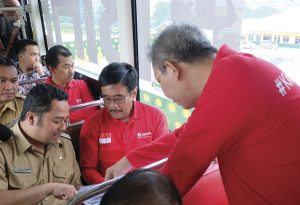 Chairman of BOCI Chattisgarh, Navsharan Singh, expressed that government response has been lacking. He mentioned that the industry has been seeking relief from the government in the area of taxation for at least six months until an amount of normalcy is had. Singh also spoke about the need for the insurance companies and the government should look into the challenges faced by bus operators. Drawing attention to private bus operators in many states like Gujarat, Rajasthan, Himachal Pradesh and Madhya Pradesh having gone on strike due to their inability to sustain or operate anymore, Singh said, “Given the gradual ramp up from the initial 30-50 per cent to 100 per cent, the challenges faced by the bus operators should be considered with impunity.” Singh also pointed out at the shortage of workers as many have chosen to return to their villages having lost confidence in their ability to sustain in cities. Said Kulwant Singh, in his ending remarks that it would take a lot of efforts and implementation of innovative ideas by the bus industry to achieve a sense of normalcy once again. Thanking the participants, he said that help from the government would go a long way in ensuring the bus industry in India gets back on its feet and starts rolling.
Chairman of BOCI Chattisgarh, Navsharan Singh, expressed that government response has been lacking. He mentioned that the industry has been seeking relief from the government in the area of taxation for at least six months until an amount of normalcy is had. Singh also spoke about the need for the insurance companies and the government should look into the challenges faced by bus operators. Drawing attention to private bus operators in many states like Gujarat, Rajasthan, Himachal Pradesh and Madhya Pradesh having gone on strike due to their inability to sustain or operate anymore, Singh said, “Given the gradual ramp up from the initial 30-50 per cent to 100 per cent, the challenges faced by the bus operators should be considered with impunity.” Singh also pointed out at the shortage of workers as many have chosen to return to their villages having lost confidence in their ability to sustain in cities. Said Kulwant Singh, in his ending remarks that it would take a lot of efforts and implementation of innovative ideas by the bus industry to achieve a sense of normalcy once again. Thanking the participants, he said that help from the government would go a long way in ensuring the bus industry in India gets back on its feet and starts rolling.



